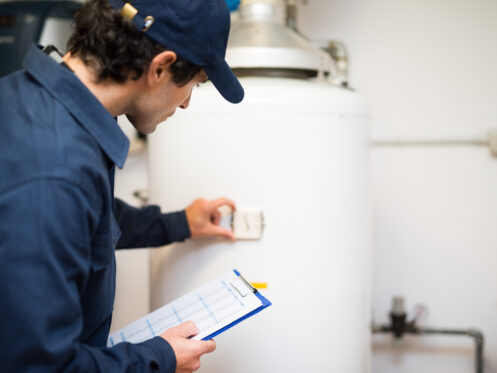Are you concerned that your water heater might be nearing the end of its life? With hot water being such a crucial part of your daily routine, a water heater failure can be a major inconvenience. That’s why watching for these signs is important, so you can act before your water heater completely gives out.
1. Tank Water Heater Is Leaking
If you have a tank water heater that’s more than eight to 12 years old, it’s important to regularly check for leaks. Water pooling underneath or dripping down the side of the tank is a concern, but it doesn’t always mean the entire unit needs to be replaced immediately. Sometimes, it’s a simple issue like a leaky inlet or outlet pipe that can be fixed by a plumber.
Faulty pressure relief valves or drain valves can also be the cause and can be easily replaced.
One of the main indicators is if you see water leaking from the bottom of the tank or around the seams. These leaks usually indicate that the tank has started to corrode. Rust inside the tank weakens its structure, increasing the risk of the tank rupturing under pressure. While not immediately catastrophic, a tank failure can cause significant water damage if it goes unnoticed.
Additionally, leaks from the top of the tank may be caused by faulty valves or pipe fittings, which are less critical and can usually be repaired without replacing the entire unit. Taking swift action to replace the water heater in this case, can help avoid costly repairs.
While waiting for a plumber, you can take steps to minimize the risk of a rupture. First, turn off the power or gas to the water heater and close the water inlet valve. Then, run the hot water in your sinks and showers to reduce the pressure inside the tank. Once the water cools, you can drain the tank to prevent further leakage.
2. Energy Bills Have Started Increasing
An increase in energy bills can sometimes be linked to your water heater. If you notice that your gas or electric bills have gone up and other major appliances like your heating or cooling systems aren’t the cause, your water heater may be the culprit. For gas water heaters, look for spikes in your gas bill during periods when you’re not using your heater or air conditioner. For electric models, higher electricity usage during mild months could point to inefficiency in the water heater.
Over time, sediment can build up inside the tank, making it harder for the unit to heat water and causing it to run longer and use more energy. Besides sediment buildup, worn-out internal components, such as heating elements or burners, can reduce efficiency and contribute to higher energy bills. While a plumber can sometimes resolve these issues with repairs or flushing the tank, increased energy consumption can also indicate that your water heater is nearing the end of its lifespan.
3. Water Heater Runs for a Long Time
If it’s taking longer than usual for your water to heat up or if your hot water supply runs out faster than it used to, it could be a sign of a declining water heater. The first-hour rating on a water heater tells you how much hot water it can supply in the first hour of use. For instance, a 60-gallon water heater might have a first-hour rating of 80 gallons, meaning it can provide more hot water than its actual capacity due to its ability to heat while in use.
If your water heater is struggling to maintain its first-hour rating or if it takes longer for your water to reheat, the unit could be losing efficiency. For gas heaters, recovery time should be around 30 to 45 minutes, while electric models might take up to 1.5 hours. If your water heater’s recovery time is longer than this, it’s likely time for an inspection or replacement. These recovery times may vary depending on the size of the unit and its age, so checking with a professional is recommended.
4. Your Water Often Isn’t Hot Enough or Is Sometimes Too Hot
If you’re finding that your water temperature fluctuates frequently, it might be more than just a thermostat issue. Older water heaters often struggle to maintain consistent water temperatures, either producing water that’s too hot or too cold. This issue can sometimes be fixed by replacing the thermostat, but if your unit is over 10 years old, this could be a sign that the entire system is failing.
Cold water or irregular heating is often an indication that the unit is not turning on when it should or that it can no longer heat water efficiently. Sediment buildup can also interfere with heating efficiency, as it insulates the heating elements or burner from the water, causing temperature inconsistencies.
5. Rusty-Looking Hot Water
Rusty water coming from your hot water taps is a sign of internal corrosion in the water heater. While flushing the tank can sometimes clear out the rust temporarily, it won’t fix the underlying problem. Over time, the tank will continue to rust, eventually leading to leaks or complete failure. If your hot water appears brown or red, it’s likely time to start thinking about a replacement. Rust inside the tank is a clear indication that the unit is nearing the end of its lifespan. The anode rod, which helps prevent rust, may need replacement if it’s fully depleted. Replacing it can sometimes extend the life of the unit if addressed early!
If you need any plumbing, heating, or air conditioning services in the Charleston area, Rudd Plumbing Heating and Air has you covered. We pride ourselves on offering top-notch workmanship and ensuring that every customer is fully satisfied. That’s why we’re the company to trust for all of your emergency services, water heater installation, repair, and maintenance needs. If you’re looking to install a new water heater, give us a call, and we’ll ensure you get the right unit for your home.

